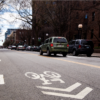
Courtesy of Street Plans
On Wednesday, city officials announced that safer streets are coming to the Elm City.
The “Safe Routes for All” plan is a blueprint of infrastructural improvements around the city, aiming to make New Haven safer and more accessible to cyclists, pedestrians and transit system riders. The plan comes as New Haven has seen a record number of pedestrian and cyclist fatalities and residents are demanding more municipal action on traffic safety.
At a virtual public workshop on Wednesday night, Director of Transportation, Traffic, and Parking Doug Hausladen ’04 called the plan a “multi-year planning process” based on concepts of tactical urbanism.
The plan was adopted by Hausladen’s department in 2019, and its first phase included a series of low-cost traffic-calming installations around the city. Over the last year, consultants from the urban planning group Street Plans have been observing New Haven’s infrastructure and working with officials to plan the city’s next steps. Now, the city is gearing up for Phase II of “Safe Routes for All.” This phase aims to connect all the city’s existing traffic projects, plans and networks to shift the focus of New Haven’s streets away from motorists to vulnerable users like pedestrians and cyclists.
“We think that everybody, no matter where they live, has a right to connect safely and efficiently to jobs, parks and social opportunities,” Street Plans Principal Mike Lydon said at the meeting. “We really view active transportation as essential infrastructure, and what we’re looking at as the focus for this planning effort is how people not driving cars can move around the community.”
Wednesday’s public workshop comes after a year of record-high pedestrian and cyclist fatalities. Many advocates have criticized the city’s lack of action towards improving traffic safety, especially in the face of its prior commitments in the 2010 Complete Streets Protocol. This “Safe Routes for All” plan, however, promises to be more inclusive of neighborhood advocates, as it gives them an active role in the process of developing the finalized master plan. This plan is set to be released in August or September.
The workshop also comes on the heels of a flurry of other public meetings hosted by the city, where Hausladen and City Engineer Giovanni Zinn ’05 invited residents to provide input on major corridors like Whalley Avenue and Valley Street.
On Wednesday, the meeting’s 60 attendees were grouped into Zoom breakout rooms by neighborhood and invited to participate in a mapping exercise to provide feedback on specific intersections or streets of concern. Former Ward 9 Alder Roland Lemar, a state representative who co-chairs the House Transportation Committee, said that resident engagement is “crucial” for officials to carry out change.
“This has been an issue that New Haven has always led on, with advocates on the local level pushing our city and state to be better on these issues,” Lemar said. “We are all better when we’re pushed by our constituents to be the best versions of ourselves.”
Residents will also be able to use the city’s new interactive map tool over the next few months to flag streets of concern for officials and community members to see. Officials say this feedback will greatly influence Safe Routes for All’s final design.
Ward 7 Alder Abby Roth used the tool to submit notices for the intersections at York Street and South Frontage Road as well as Temple and Chapel streets, both of which have seen recent pedestrian fatalities. Another concern is the timing of the pedestrian signals at the intersection of Church and Chapel streets, which resident Lior Trestman noted is a high-foot traffic zone located along a congested bus corridor. Meanwhile, the East Shore/Morris Cove group expressed a community desire to better connect their neighborhoods to downtown with cycling access.
Though much of Wednesday’s workshop focused on reducing traffic hazards, the city said they hope that making streets more walkable and bikeable will also improve residents’ health. Hausladen’s department has engaged with the Community Alliance for Research and Engagement, or CARE, throughout the plan’s development in an effort to build an environment more conducive to exercise and healthy behavior.
“We need to improve the communities in which we interact every single day … looking beyond individual behavior change and looking towards community and systemic change,” CARE Director Alycia Santilli said. “There are lots of ways to get around besides cars, and so this plan is a way of creating a healthier city.”
According to senior project manager Dana Wall, Safe Routes for All is based on a review of existing traffic studies and driven by a publicly available database collected about every intersection throughout the city, including information about crosswalks, signals and sidewalks. One of the plan’s primary goals is to create New Haven’s first citywide bicycle and pedestrian greenway network, which would connect slow-speed neighborhoods and roads. Street Plans, the urban planning group that has been developing the project, says eight of the city’s 21 neighborhoods currently have no bike lanes at all.
Advocacy groups like the Safe Streets Coalition of New Haven, which made a strong showing at Wednesday’s meeting, appear poised to support the plan. The Safe Streets Coalition has already coordinated with officials like Hausladen and Zinn to identify problem areas and explore solutions at their monthly mobilization meetings.
Ward 27 Alder Richard Furlow addressed the community Wednesday night, and said he is encouraged by the community’s readiness to engage.
“This plan is so important to the culture of safety we are trying to establish in New Haven,” Furlow said. “We are all so frustrated about the accidents and the pedestrians that are being hit. So I’m really happy to see so many interested partners and community stakeholders coming together to solve this very serious issue in our city.”
A second public workshop for the Safe Routes for All Plan’s second phase will be held in June.
Isaac Yu | isaac.yu@yale.edu
Interested in getting more news about New Haven? Join our newsletter!









